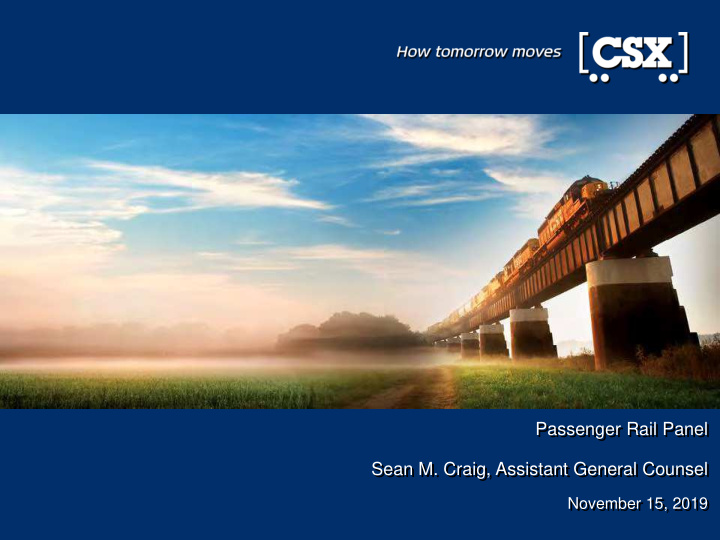



Passenger Rail Panel Sean M. Craig, Assistant General Counsel November 15, 2019 1
Passenger trains operate on ~3,300 miles, or 16% of the CSX network CSX Trains Avg. Daily Miles Hosts: per Day Ridership on CSX Amtrak 40 10,000 3,226 MARC 40* 12,500 116 VRE 32 19,500 59 Total 112 ~42,000 *Does not include Friday Brunswick extra CSX is a tenant on: − MBTA − Amtrak NEC/Hudson Line − Metro North − SEPTA − SunRail − Tri-Rail − METRA 2
CSXT’s approach with Passenger Agencies Build trust through shared safety culture Prove we are their partner Commitment Demonstrate shared commitment to improvements Help communities understand freight / passenger challenges Communication Actively manage agency relationships Proactively provide information to passengers Coordination Address passenger concerns upfront 3
CSX requires new passenger operations to pass the following four tests: SAFETY – Safety cannot be compromised CAPACITY – Capacity must ensure safe and reliable operations and ensure access and room for current and future freight customers COMPENSATION – Compensation must offset all expenses of the additional passenger service LIABILITY – Indemnified against any new liability that, but for the new passenger service, would not exist 4
Modeling is needed to analyze operations and to facilitate the development of sound investment plans on a dynamic network The modeling process attempts to … Measure impact of modifications to physical plant Minimize capital expenditures Avoid design mistakes Plan investment timing (prioritize) Develop long range facility plans Plan for future traffic schedules and volume Identify and test solutions to improve rail flow and reduce delay Utilize model results to analyze schedules 5
To insure safe operations, passenger trains operating above 90 MPH must do so on dedicated tracks separated from freight. Sealed from highways and pedestrians – HSR requires grade separations Dispatched and maintained by the passenger entity – CSX core business is moving high tonnage trains at conventional speeds If the right-of-way is shared, the freight operator must be able to access both its present and future customers to meet its common carrier obligation. – Freight carriers must not be isolated on one side of the right-of-way 6
Passenger Projects that diminish existing and future freight capacity are inconsistent with the true objectives of planners. A cost-effective, reliable freight rail system is vital to state economies Absent additional capacity, new passenger trains diminish freight capacity: – More trucks on the highway – Congestion on vehicular arteries increases – Pollution increases Passenger agencies that consume the existing, “cheap” capacity for passenger trains must: – Replace the capacity consumed, previously available for future freight demands – Add capacity required to maintain fluidity as the freight volume returns • Passenger operations must be transparent to freight operations • Detailed modeling required 7
Recommend
More recommend